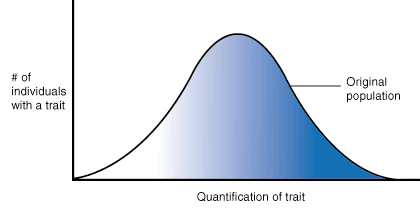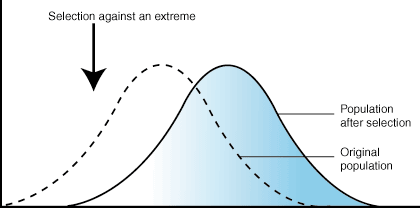@ Natural selection @ can take many forms. To make talking about this easier, we will consider the distribution of traits across a population in graphical form. In we see the normal bell curve of trait distribution. For example, if we were talking about height as a trait, we would see that without any selection pressure on this trait, the heights of individuals in a population would vary, with most individuals being of an average height and fewer being extremely short or extremely tall. However, when selection pressures act on a trait, this distribution can be altered.

Stabilizing selection
When selective pressures select against the two extremes of a trait, the population experiences stabilizing selection. For example, plant height might be acted on by stabilizing selection. A plant that is too short may not be able to compete with other plants for sunlight. However, extremely tall plants may be more susceptible to wind damage. Combined, these two selection pressures select to maintain plants of medium height. The number of plants of medium height will increase while the numbers of short and tall plants will decrease.

Directional selection
In directional selection, one extreme of the trait distribution experiences selection against it. The result is that the population’s trait distribution shifts toward the other extreme. In the case of such selection, the mean of the population graph shifts. Using the familiar example of giraffe necks, there was a selection pressure against short necks, since individuals with short necks could not reach as many leaves on which to feed. As a result, the distribution of neck length shifted to favor individuals with long necks.

Disruptive Selection
In disruptive selection, selection pressures act against individuals in the middle of the trait distribution. The result is a bimodal, or two-peaked, curve in which the two extremes of the curve create their own smaller curves. For example, imagine a plant of extremely variable height that is pollinated by three different pollinators, one that was attracted to short plants, another that preferred plants of medium height and a third that visited only the tallest plants. If the pollinator that preferred plants of medium height disappeared from an area, medium height plants would be selected against and the population would tend toward both short and tall, but not medium height plants. Such a population, in which multiple distinct forms or morphs exist is said to be polymorphic.

(154)
You May Also Like
-
Feb 10, 2025
-
Feb 4, 2025
-
Jan 22, 2025
-
Nov 19, 2022
Get in touch
Call us directly?
Address
